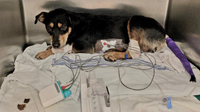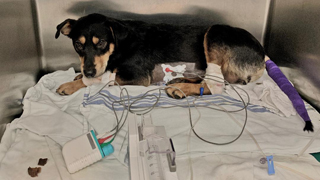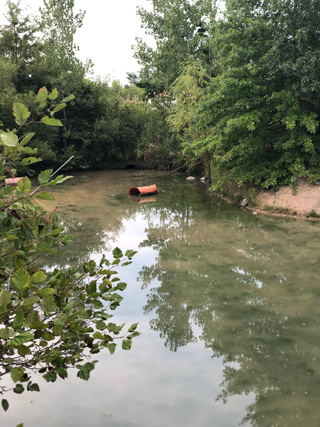
Larry 320

Photo courtesy of Christopher Celi
A 2-year-old hound-shepherd mix named Larry nearly died after drinking water believed by his owner to be contaminated by toxic blue-green algae in Madison, Wisconsin.
Larry the hound-shepherd mix may be one of few dogs to survive ingesting water laden with toxic blue-green algae — a poisonous and microscopic bacteria that have caused the death of dogs this summer throughout the United States and Canada.
Owner Christopher Celi credits the University of Wisconsin's veterinary teaching hospital for saving the 2-year-old dog, now home and resting following six days of critical and supportive care.
In an interview with the VIN News Service, Celi described taking Larry on July 31 to a waterway at Tenney Park in Madison, Wisconsin. He never suspected that the lagoon might be contaminated with toxic blue-green algae.
Toxic blue-green algae is not actually algae but a toxic microorganism called cyanobacteria that contains chlorophyll, which makes it look similar to plant matter. It thrives in warm and stagnant freshwater lakes and ponds that are fed by fertilizer runoff and sewage. The bacteria can cause skin irritation and gastrointestinal issues in humans; it can kill animals within 15 minutes of exposure. Seasonal outbreaks are common; every summer, people and pets fall ill from exposure to cyanobacteria. According to media reports, bans are in place on swimming and drinking from bodies of water in North Carolina, Georgia, Texas, Mississippi and Florida. The blue-green algae also has been identified in New Jersey's Lake Hopatcong and in Toledo, Ohio, where strong winds have mixed the blooms with Lake Erie's deep waters. One patch is large enough to be seen from space.
Toxic blooms often look like green paint floating on water, but also can appear to be bluish, brownish or reddish green before eventually breaking down in the water to be destroyed naturally. While Celi didn't see the algae, he said it was present during his visit to the park with Larry.
Pond 320

VIN News Service photo
Toxic blue-green algae isn't a plant but a dangerous bacteria that can appear in a variety of colors. Experts suggest staying away from murky, standing bodies of water, especially during hot summer months. Signs of a toxic bloom include dead fish or other animals; sudden unexplained sickness or death of dogs and cats; and skin rashes on people who swim in the water.
"The lagoon didn't show classic signs of blue-green algae, but there were other beaches on Lake Mendota, which is part of the same waterway, that were closed because of it," Celi said. "We were walking along the shoreline of the lagoon, and Larry wasn't even swimming, he was standing in the water. But then I saw him drink some of it."
That evening, Larry was weak and lethargic. He had no appetite the following day and by evening, started vomiting, collapsing and defecating. Celi rushed Larry to UW Critical Veterinary Care, where his condition worsened quickly.
Consulting with experts, Celi believes that Larry ingested water contaminated by cyanobacteria, or toxic blue-green algae.
"In less than three hours, I went from thinking he was going to be OK to hearing that he might not make it through the night," he said. "I was told his liver was definitely failing and his blood wasn't coagulating. He had started vomiting blood, and blood was coming out of his rectum.
"They were supporting his system just to keep him alive. It was horrifying."
While Larry has bounced back, the dog's liver and heart are compromised and being monitored. "He's getting close to normal, but not quite," Celi said. "He does have a lot of his personality back, and I can't wait for the vet hospital staff, who really saved his life, to meet the 'real' Larry soon."
Veterinarians wish all toxic cyanobacteria encounters ended so well. On a message board of the Veterinary Information Network, an online community for the profession and parent of the VIN News Service, Dr. Eliza Wilby of Austin, Texas, described the case of a dog who had visited a popular swimming spot in nearby Red Bud Isle Park.
"About 20 minutes after coming home, she stumbled and collapsed while going down the stairs. Mom brought her right in," Wilby wrote in a recent VIN discussion.
The dog presented unable to walk with muscle tremors, hypersalivation and dilated pupils. "Within a few minutes, she suffered respiratory arrest" and died, Wilby wrote. "… Mom was absolutely hysterical."
Colleagues on VIN said the dog's symptoms fit cyanobacteria toxicity. Having never before seen a case, Wilby was distressed. "I felt like I was chasing a boulder down a hill trying to treat this dog," she wrote.
Since then, several other dogs that visited Red Bud Isle also have died. City health authorities closed the park on Thursday after confirming the presence of toxic algae blooms. Just the sight of blue-green algae cannot predict the amount of the toxin in water, environmental experts say. Water samples must be analyzed to confirm that a bloom is harmful to people and animals.
There's no easy test to identify cyanobacteria toxicity and it's hard to treat, said Dr. Tony Johnson, a VIN consultant who's board-certified in emergency medicine.
"Like many naturally occurring toxins, all bets are off. There's no antidote," he said. "That doesn't mean there's nothing we can do; we can do supportive care. But these bacteria are mean and nasty, and for those severely affected, there's a strong possibility it's going to be fatal."
For that reason, Johnson advises owners to avoid stagnant bodies of water in the summer.
"If you're going to a big old pond that has scum on the surface, I'd go the other way," he said. "Swimming in the pool is far safer."